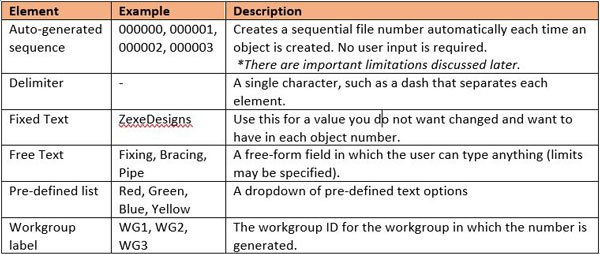Here is a quick guide on creating and using numbering schemes in Autodesk Vault.
Introduction
Central to proper data management is the appropriate naming of designs and files. While there are many different types of numbering schemes, some suited to particular purposes more than others, it is traditionally a matter of discipline to enforce their use and sequence. In the past, the discipline was enforced by a human document controller equipped with an Excel spreadsheet. Today, users of Autodesk Vault can make use of its automatic numbering utility for their design files. This article will look into the setup, use and limitations of automatic numbering in Autodesk Vault.
Numbering Schemes in Vault
Vault can support and enforce several numbering schemes concurrently. Numbering schemes are each composed of a sequence of definable elements; these elements are tabulated to the right.
An example using some of these elements may be:
[Project] – [Auto-generated sequence] – [Variant]
Composed of:
[Pre-defined list] [Delimiter] [Auto-generated sequence] [Delimiter] [Free Text]

In practise, files generated in such a system may look like this:
1000-002144-01
2000-000059-00
2000-000060-00
4000-000001-04
When are Numbering Schemes applied?
After they are set up in Vault, Numbering Schemes are applied when the user creates and saves a file in Vault, Inventor, AutoCAD or Microsoft Office. The default scheme may be changed. They can also be called upon during a Design Copy executed within Vault.
Limitations
While numbering schemes are incredibly helpful, there are a few limitations that one must keep in mind when using them:
Limitation 1: A number cannot incorporate the revision
Some traditional numbering schemes incorporate the revision of a file into the numbering scheme itself. For example: 1000-006642-01-REV1
While Vault could probably be bashed into achieving such a numbering scheme, it is certainly not native, and not recommended.
Limitation 2: Prefixes start new Sequences
If a numbering scheme contains a sequence (an automatically-incrementing digit sequence), it will begin a NEW sequence if any character before the sequence is changed. For example, the following 4-6-2 numbering scheme (the sequence element is italicised).
2000-000000-00
2000-000001-00
2000-000002-01
2000-000003-00
4000-000000-00
4000-000001-00
2000-000004-00
2000-000005-01
4000-000002-00
For the 4-6-2 numbering scheme, this is excellent if the first 4 digits denote separate projects; in this case, you’d want separate sequences for separate projects. However, if the first 4 digits denote a prefix (such as 1000 = Tools, 2000 = Production, 4000 = Extras, etc) you will find this limitation to be unhelpful.
Limitation 3: The sequence is incremented the instant that a ‘Save’ is executed
Due to the multi-use nature of Vault, an instant must be selected for the incrementing of an automatically generated sequence. The instant is at the point of saving, and not the initial check-in into the Vault. If a user does not check all their saved files into Vault, there may be an apparent gap in the sequence – not ordinarily a trouble, but worth knowing.
Conclusion and Recommendations
Numbering schemes in Autodesk Vault are an excellent way to enforce file-naming discipline. They work best when they are:
– Simple to read and easy to use
– Managed by a single class of a user (typically the CAD manager)
– Considerately crafted early on.
From my own experience, the 4-6-2 numbering scheme mentioned earlier is clean and easy-to-use, although the ideal numbering system for your own work may require another system entirely. There is no consensus on the ‘perfect’ numbering scheme, and it is up to us as managers of data to find that which will work for us.


